Zanzibar, otherwise known as Spice Island, is a tropical island situated 35 kilometres off the coast of Tanzania in East Africa.
Still a hidden-gem beach destination, it’s famous for its rich cultural history, cloves and other spices and diversity of marine life, offering a world of underwater adventures on its doorstep.
The island forms part of an archipelago of over a dozen small islands.
Roughly 180,000 tourists visit the island annually to scuba dive, snorkel and explore the bright blue waters of this untouched paradise. Zanzibar is easy to reach from the mainland and is extremely safe for tourists.
This page is my complete guide to Zanzibar. It's a perfect short read, and ideal for planning your holiday in Zanzibar.
My Quick Takeaways:
Planning a trip to Zanzibar? Here’s what you need to know at a glance:
- Exotic Location: Known as the "Spice Island", Zanzibar is a tropical archipelago 35 kilometres off the coast of Tanzania in East Africa.
- Rich Cultural Heritage: A melting pot of African, Arab, Indian, and European influences, reflected in its architecture, cuisine, and vibrant traditions.
- Stunning Beaches: Famous for white sandy shores and crystal-clear waters, Zanzibar is perfect for relaxation and water-based activities.
- Incredible Marine Life: The warm Indian Ocean offers fantastic snorkelling, scuba diving, and dolphin spotting opportunities.
- Spice Tours: One of the world’s top producers of cloves, nutmeg, and cinnamon, making spice farm tours a must for visitors.
Ready to explore Zanzibar? Let's dive into my ultimate Zanzibar guide.
Day tours in Zanzibar? Here are my top picks...
- Quad bike tour to a local village (4 hours)
- Stonetown food market and street food walking tour (3 hours)
- Zanzibar spice tour with traditional cooking lesson (3 hours)
- Rock restaurant and cave tour (6 hours)
- Private tour to Prison Island (3 hours)
Zanzibar FAQs
When is the best time to travel to Zanzibar?
Zanzibar is a fantastic year-round destination, but it does have a definite high season.
The high season is the dry season which is from July to September, but this is also the peak busy time as it’s school holidays.
November and December are also good times to visit when the rains are short and the days are sunny.
Most of the year the temperatures hover between 28°C and 34°C. The long rains arrive in April and May when the humidity peaks and the temperatures soar.
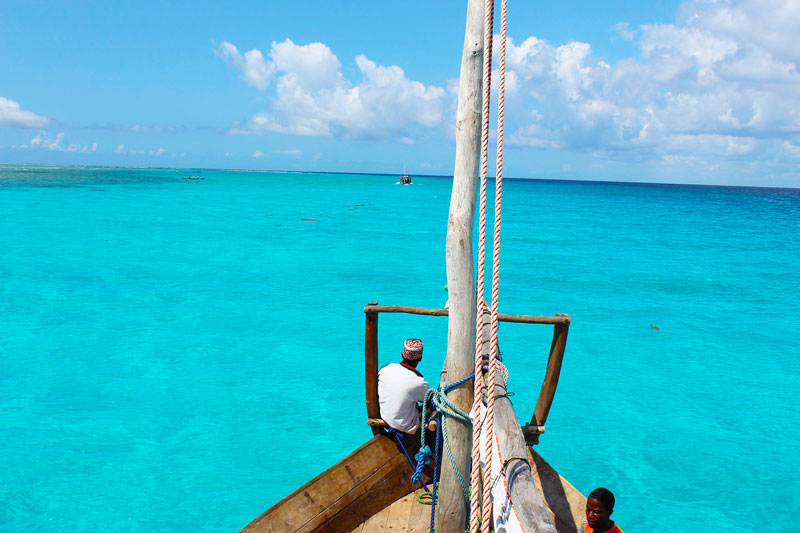
Do I need a Visa for Zanzibar?
Zanzibar is part of the Republic of Tanzania and holiday visas are required for most countries. A handful of countries are exempt from visas.
A few of these countries include nationals from South Africa, Singapore, Seychelles, Mozambique, Malta, Hong Kong, and Malaysia. Most African countries don’t require visas to enter Tanzania.
Visas can be obtained through Tanzania’s e-visa system where travellers can double-check if their country of origin is on the visa requirement list. The e-visas need to be booked in advance.
Volunteers will need a work permit which can be done through the Tanzanian immigration website, or the volunteer organisation directly. Travellers will need at least 6 months on their passport.
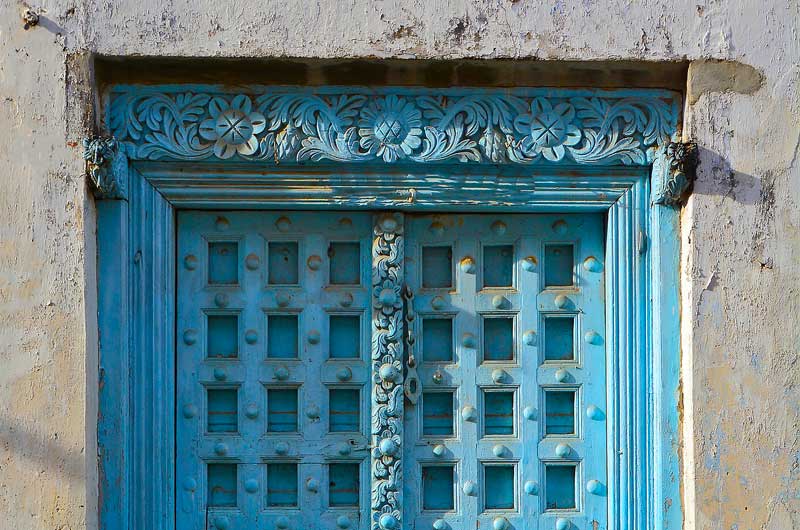
How do I get to Zanzibar?
Many flights land on the main island of Unguja or Pemba. Most international flights go to Dar es Salaam on the mainland.
Depending on the budget, visitors can either fly into Stone Town or take a ferry, which is the budget option.
Use my Zanzibar Map below to orientate yourself with the major beaches and hotels!
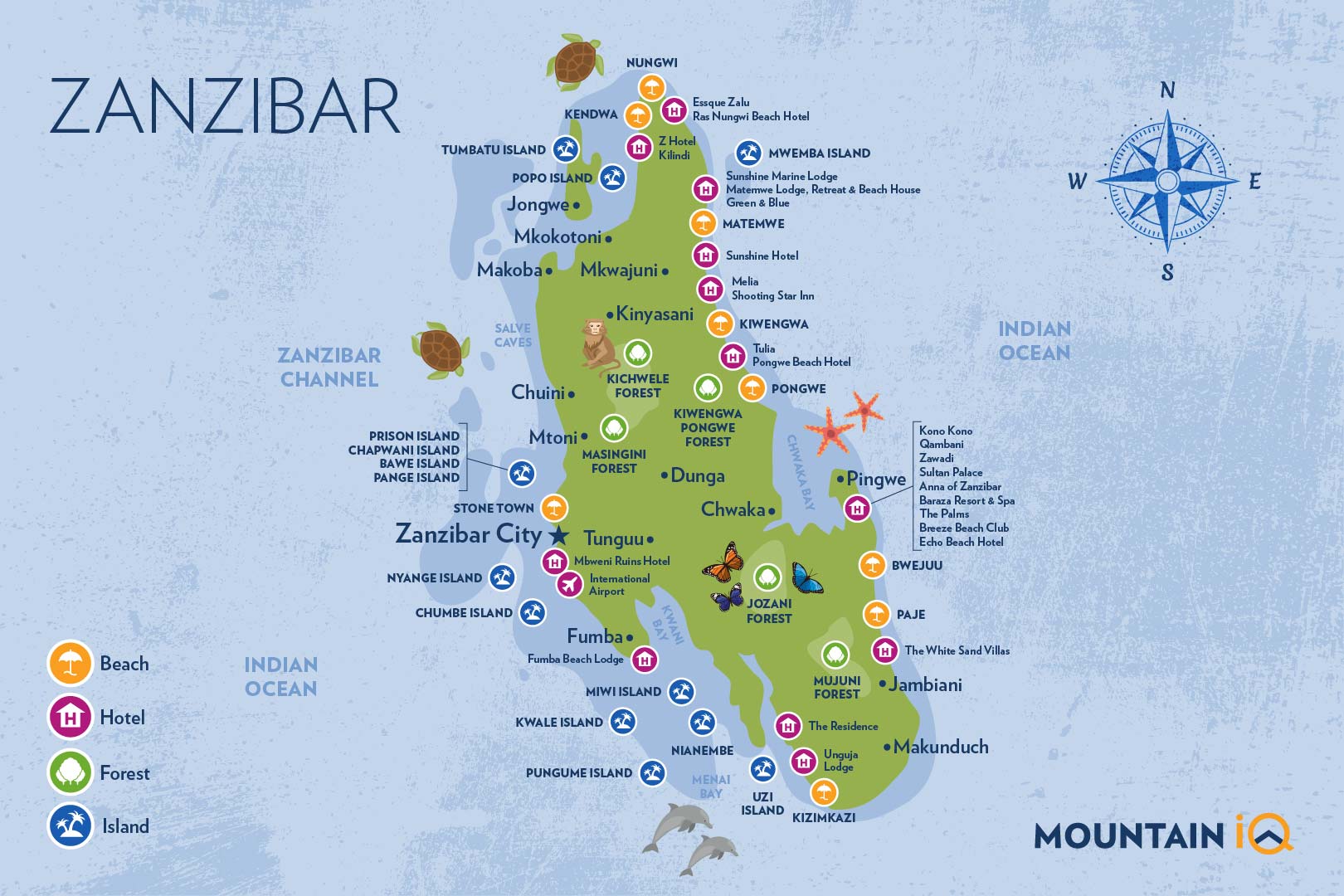
How expensive is Zanzibar?
For 2 people, it costs roughly $4,285 for a week’s holiday in Zanzibar. A hotel stay can cost anything from $38 to $217 our night.
Compared to other African destinations, Zanzibar does not come in cheaply. It is possible to do activities in Zanzibar on a budget, but the resorts can be costly.
The villages and towns are generally quite cheap. Food and drink wise, it’s very reasonable. On average, a beer will cost $1,50.
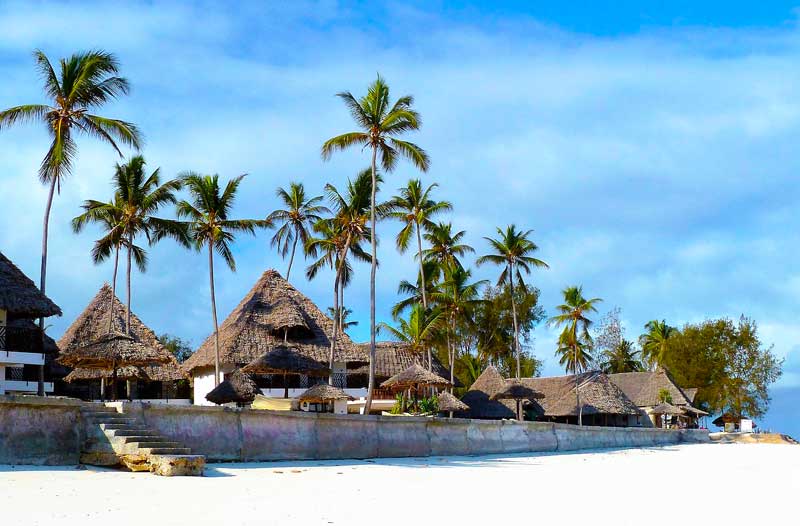
Where to stay in Zanzibar?
See my guides on Zanzibar Hotels and Tanzania Safari Resorts which list the most luxurious, best value for money, superb for a honeymoon or a family vacation accommodation options on the main Zanzibar Island.
Starting from the most expensive to the lowest price per night.
Where to stay? Here are 5 of my favourite accommodation options in Zanzibar:
- Melia Zanzibar (see prices)
- Z Hotel (see prices)
- Park Hyatt Zanzibar (see prices)
- Zuri Zanzibar (see prices)
- Sevi Boutique Hotel
See more Zanzibar accommodation options.
What tropical diseases can be found in Zanzibar?
Zanzibar is safe, but mosquitoes can be a problem – especially when temperatures become extreme. Zanzibar is a high-risk malaria area, and visitors should take care.
As well as bringing along anti-malaria ointments, travellers should consider taking either one of the following anti-malaria pills: Doxycycline or Atovaquone/Proguanil, or Mefloquine.
It’s advisable to check with your local health practitioner about what to take.
What languages are spoken in Zanzibar?
Zanzibar is a melting pot of cultures, which means a variety of languages are spoken, Swahili is the main language, but Arabic, English, Italian and French are also spoken.
The two official languages are English and Swahili.
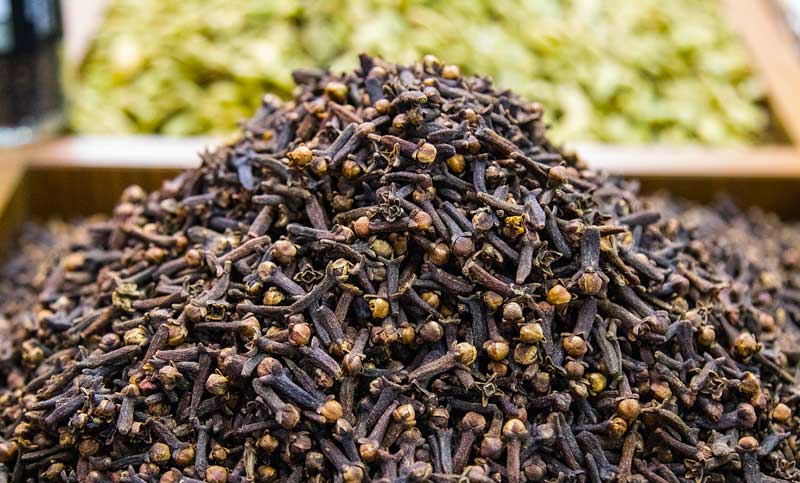
Zanzibar cloves
What are Zanzibar’s famous spices?
Because of its past in trading spices, the island earned its nickname The Spice Island. Zanzibar’s main spice exports include clove, chilli, black pepper, nutmeg, cardamom, turmeric, and cinnamon.
Cloves are the most commonly produced spice.
Other spices grown on the island include vanilla, saffron, and lemongrass. Several spice tours are available, ranging from visits to plantations outside of Stone Town to smaller agricultural rooms where some spices are grown.
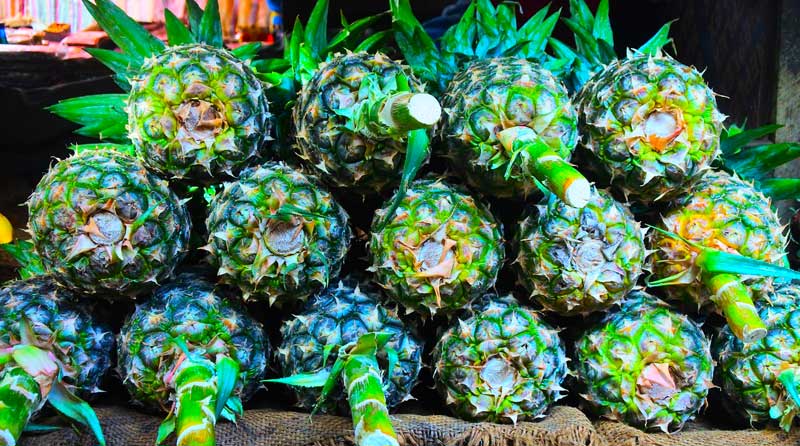
Zanzibar Food and Local Cuisine
Zanzibar cuisine is a mix of the cultures that influenced the island. The cuisine is a mix of Arab, Indian, Portuguese, British, Chinese, and Swahili, and utilises a range of local spices. Dishes are often rich and exotic, packed with flavour.
One of the most popular Zanzibar dishes on the island is the Spice cake, which is available in almost every town and village. The iconic Spice cake is made from cloves, nutmeg, chocolate, and cinnamon.
Zanzibar Beaches
Beach Culture
In terms of tourism, visitors usually visit the main island of Zanzibar for its beaches, culture, and unique towns. The northeast of the island is the most coveted area as it has pristine beaches, diving, and high-end accommodation.
Some travellers combine a visit to other islands in the archipelago which include Pemba Island, known for its green hills, clove plantations, rich fishing grounds and dolphin safaris.
Overall, Zanzibar main island (Unguja), is the most visited and can be accessed easily from the mainland by ferry. This island in East Africa is geared towards tourism. This is how to combine a beach holiday with a Tanzania safari.
Below is a list of popular tourist towns on Zanzibar Island.
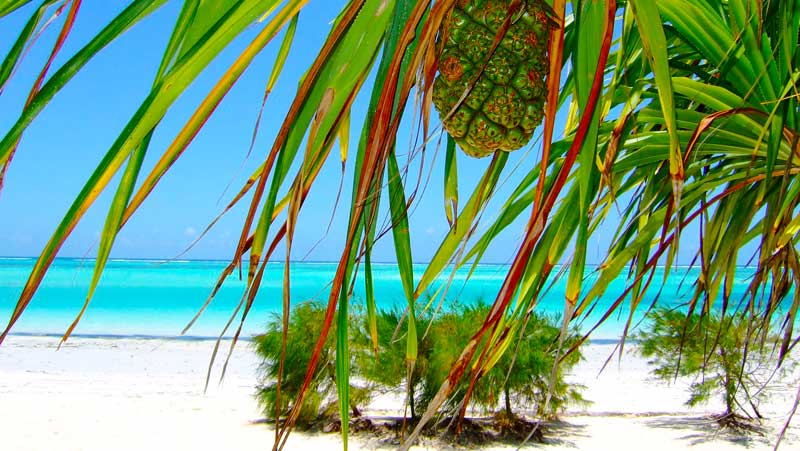
Main Zanzibar Beach Villages
Nungwi and Kendwa
Nungwi and Kendwa are palm-fringed beach villages located on the northern tip of Zanzibar Island.
They are sought-after destinations on the island and can become quite crowded during the season.
Day tours in Zanzibar? Here are my top picks...
- Quad bike tour to a local village (4 hours)
- Stonetown food market and street food walking tour (3 hours)
- Zanzibar spice tour with traditional cooking lesson (3 hours)
- Rock restaurant and cave tour (6 hours)
- Private tour to Prison Island (3 hours)
Swimming can be done at both low and high tide, there’s also a tidal lagoon.
Just off the coast in this part of the island, there are rich coral reefs with plenty of marine life, making it popular for boat trips and diving tours.
Both villages are the centre for building and producing the traditional dhow, a trading and sailing vessel. Kendwa is believed to have the better beach and is home to the famous Zanzibar Full Moon party.
It’s also popular with guests seeking an activity-based lively beach holiday.
Once a destination favoured by Bohemians and hippies, Kendwa is lined with affordable rustic resorts and beach bars.
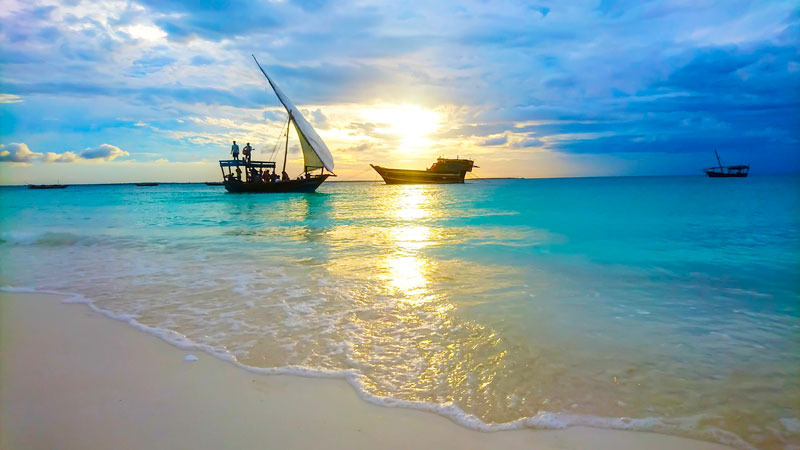
Volunteer projects in Zanzibar normally take place in Nungwi, and are centred around turtle and rainforest and coastal conservation.
Green and hawksbill turtles are sheltered in a tidal lagoon that’s monitored by the Mnarani Marine Turtle Conservation Pond. Visitors interested in volunteering in Zanzibar can expect to pay roughly $540 per week.
For most holidaymakers, access to pristine white beaches is a must. An in-demand Zanzibar hotel in Nungwi is the DoubleTree Resort by Hilton Zanzibar.
The resort is sandwiched between palm groves and the actual village.
Day tours in Zanzibar? Here are my top picks...
- Quad bike tour to a local village (4 hours)
- Stonetown food market and street food walking tour (3 hours)
- Zanzibar spice tour with traditional cooking lesson (3 hours)
- Rock restaurant and cave tour (6 hours)
- Private tour to Prison Island (3 hours)
Jambiani
The tiny fishing village of Jambiani is ideally located between the towns of Paje and Makunduch on the southeast coast of Zanzibar.
Comprising of a few small villages, it’s a quieter destination but has many restaurants, hotels, and guest houses.
The area is well-known for having that authentic Zanzibar feel, where dugout canoes are still used for transport.
It’s also known for its local seaweed farming activities, and locals are only too happy to share their knowledge about this vital source of agriculture.
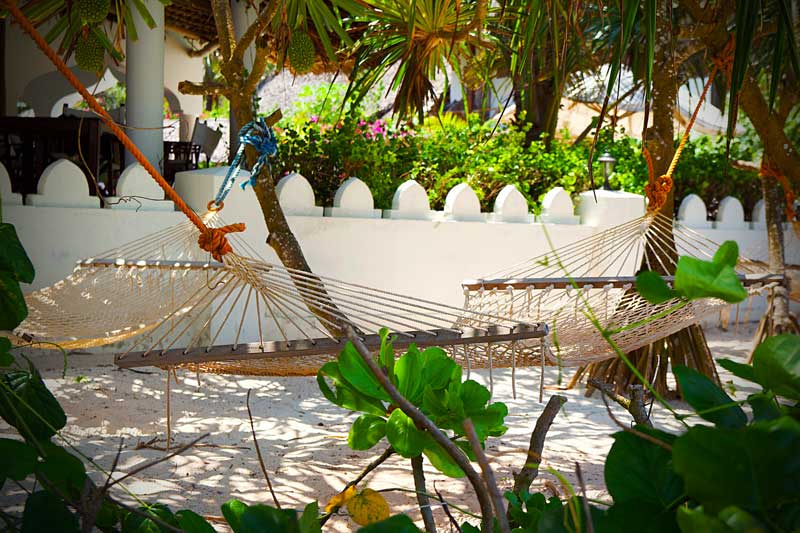
Michamvi
The Michamvi peninsula is perfect for honeymooners. It’s a remote area on the southeast coast, offering a quiet and serene beach experience.
Visitors flock to Michamvi to witness some of the country’s best sunset viewpoints.
Michamvi is home to premier resorts and luxury accommodations. There is quite a famous restaurant called “The Rock” that’s built upon an outcrop. Guests would have to take a boat just to visit this unique restaurant.
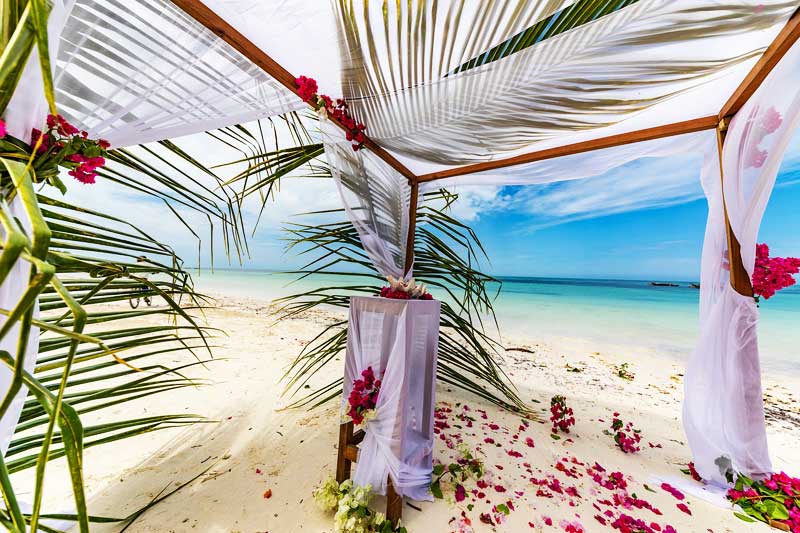
Geography of Zanzibar Island
Zanzibar is a relatively low-lying island flourishing with coconut palm groves, mango trees, banana tree plantations, coastal ferns, and tropical flowers.
In fact, there are over 4,500 species of plants on the island.
Zanzibar is relatively flat and is only 90 kilometres long and 40 kilometres wide, and is surrounded by the warm azure waters of the Indian Ocean which are popular for snorkelling and diving.
The top-rated snorkelling in Zanzibar is within the protected marine reserve on Chumbe Island, a 45-minute boat journey from Stone Town.
Many tourists head to Chumbe on a day trip, which can be organised by private tour guides or through Tanzania hotels. This tour offers some of the best snorkelling in East Africa with a locally prepared lunch.
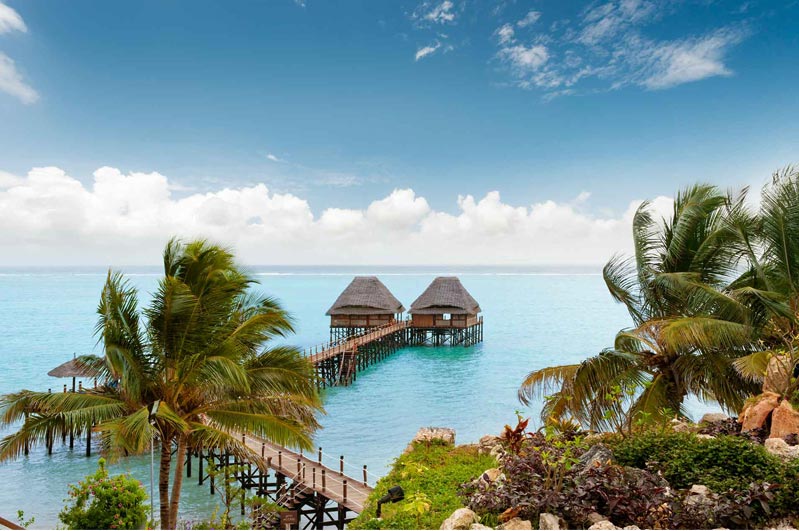
The more northern stretches of the island have undulating terra, forming part of a ridge that peaks at 119 metres above sea level.
The vegetation here is mainly patches of evergreen rainforests. Because of the altitude, there are a number of streams and rivers on this part of the island.
A variety of beaches dotted around the island offer visitors an opportunity to spot nesting turtles, particularly in Nungwi area where volunteer turtle conservation projects take place.
This varied coastal ecosystem provides the perfect habitat for a wealth of wildlife. Red colobus monkeys, lemurs, civet, antelope, mongoose, and – very rarely – leopards.
There are no lions in Zanzibar: these sightings are in Tanzania’s Serengeti. 30 snake species and 20 species of bats can also be spotted.
The tropical waters are home to colourful coral reefs teeming with reef fish, nudibranch, sea horses, Mantis shrimp, crocodile fish, and octopus.
Bottlenose dolphins, turtles, and humpback whales are frequently spotted in the Mnemba Atoll.
Day tours in Zanzibar? Here are my top picks...
- Quad bike tour to a local village (4 hours)
- Stonetown food market and street food walking tour (3 hours)
- Zanzibar spice tour with traditional cooking lesson (3 hours)
- Rock restaurant and cave tour (6 hours)
- Private tour to Prison Island (3 hours)
Zanzibar Historical Sights
Zanzibar has an interesting history and was the former centre of both the spice and slave trades.
The archipelago was a stop-over base for traders sailing from Iran, India, parts of Africa, and the Arabian Peninsula.
Stone Town was the most accessible area, so several mosques were built in the Swahili Coast. As a result, Zanzibar’s food, lifestyle and culture of today is a mix of various African, Middle Eastern, and European influences.
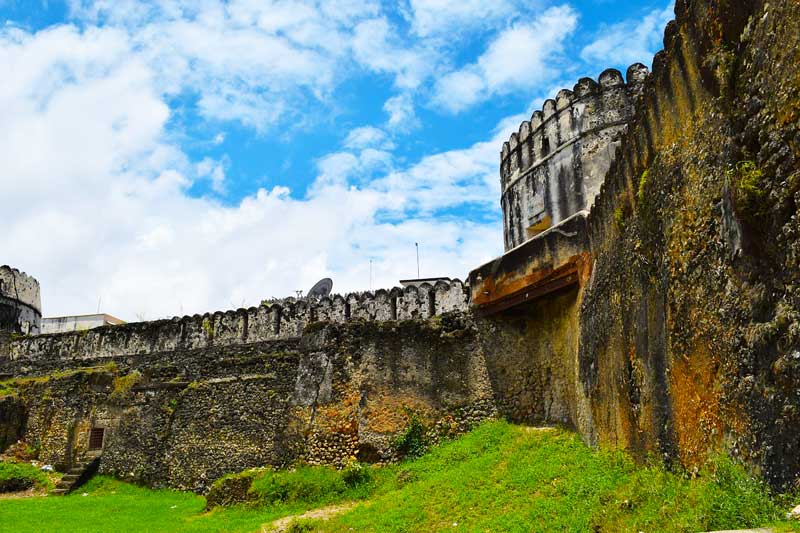
Following the ruling of the Portuguese empire, the Sultanate of Oman took control and created a cash crop trade.
There is still evidence of a small amount of ancient pottery (less than 1%) dating back to the 5th and 8th centuries from the Gulf.
It hasn’t always been smooth sailing with the combination of various cultures and ruling empires.
During the 1960s, Zanzibar enjoyed a short period of independence after a protectorate since the 1890s ended.
However, there was major upheaval between the Zanzibar Africans who made up 56% of the population, and the Zanzibar Arabs who made up 17% of the population.
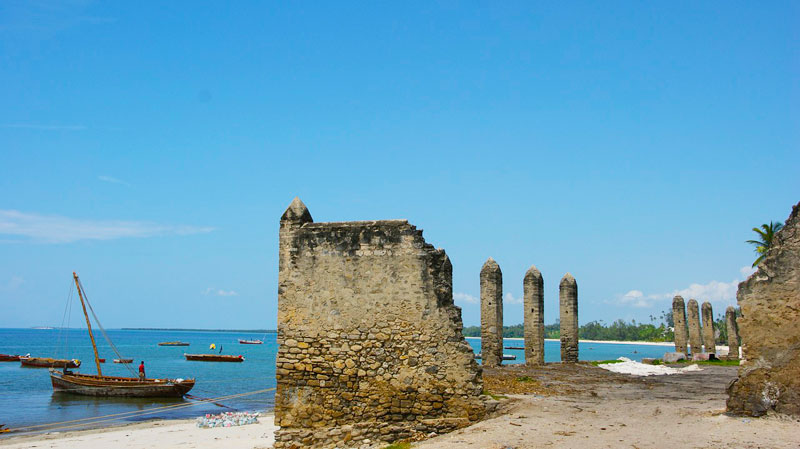
During the Zanzibar revolution in 1964, the Sultan was deposed, and during the war, over 20,000 people were either killed or fled the island.
It then became the People’s Republic of Zanzibar and Pemba, and then merged with the mainland to become the United Republic of Tanzania but remains a semi-autonomous state.
In 2010, rival parties were allowed to form governments of national unity, which is supported by 66% of voters.
Healthcare in Zanzibar is good. Healthcare is of a high standard, and the infant mortality rate in Zanzibar is 10% lower than in mainland Tanzania.
The child mortality rate of 21.5% is also significantly lower than on the mainland. In addition, only 7% of children suffer from malnutrition, which is lower than the world average of 67.2%, as recorded in 2010.
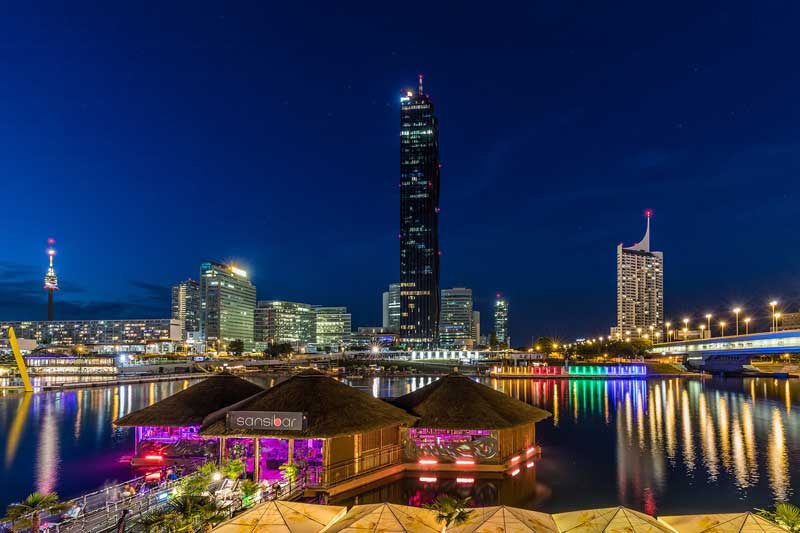
Zanzibar City
The Capital – Stone Town aka Zanzibar City
Stone Town is Zanzibar’s enchanting capital city situated in the old harbour.
The town is a UNESCO cultural heritage site and has architecture dating back to the 10th century. Towards the 19th century, Stone Town became a trading town and was one of the world’s last remaining open slave markets.
Today, Stone Town has a number of ancient buildings and the entire town is a labyrinth of narrow streets.
With a unique mix of European, Indian, and Arab influences, it’s small and safe, with a buzzing night market frequented by tourists.
Visitors to Stone Town can stay in the Protea Hotel Zanzibar Mbweni Ruins, the perfect place to enjoy relaxing beach vibes and a bit of local history. This hotel offers boutique luxury close to mangrove forests, beaches and the Mbweni Ruins.
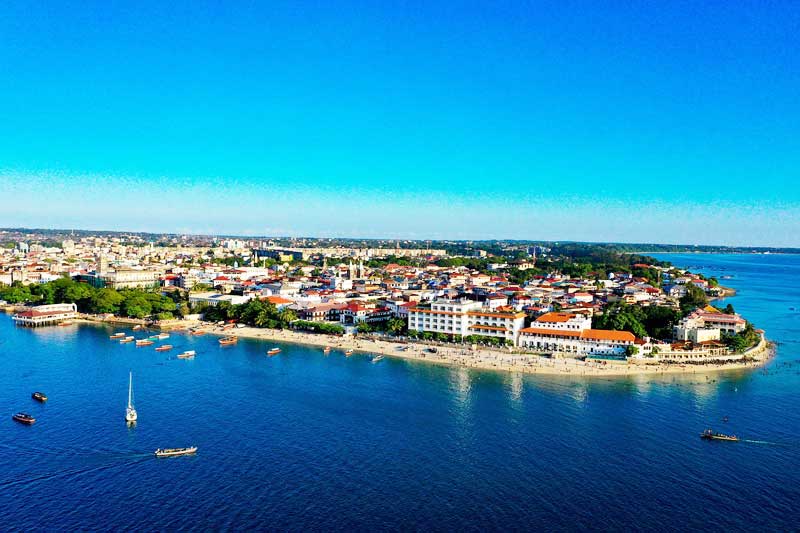
Stone Town
Customs and Traditions
Tourism activities in Zanzibar make up 49% of the economy, so locals are known for being incredibly friendly and welcoming of tourists. They enjoy a slow-paced, humble life on the main island.
In total, there are 1.3 million people in Zanzibar, and the main religion is Islam.
Tourists are advised to respect the local customs and cultures, particularly in the capital, Stone Town, where it’s frowned upon to wear revealing clothing and engage in rowdy behaviour.
You can drink alcohol in Zanzibar, but many of the locals don’t indulge. Many of the island’s resorts, expat bars, and hotels will serve alcohol, but there are only a few bottle stores on the island.
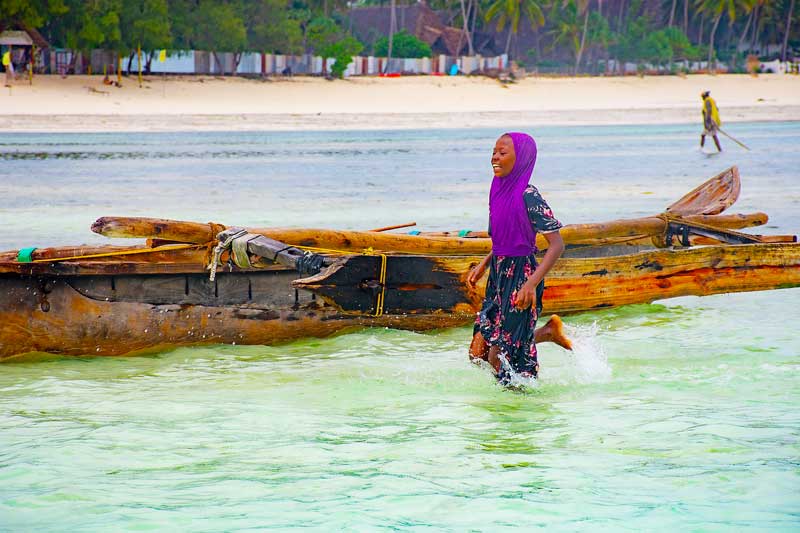
Great Wildlife of Zanzibar
The archipelago has phenomenal wildlife that can be observed in protected areas, like Jozani Chwaka Bay National Park, as well as various wildlife reserves and marine parks.
The wildlife in Zanzibar occurs all around the island and along the coastline.
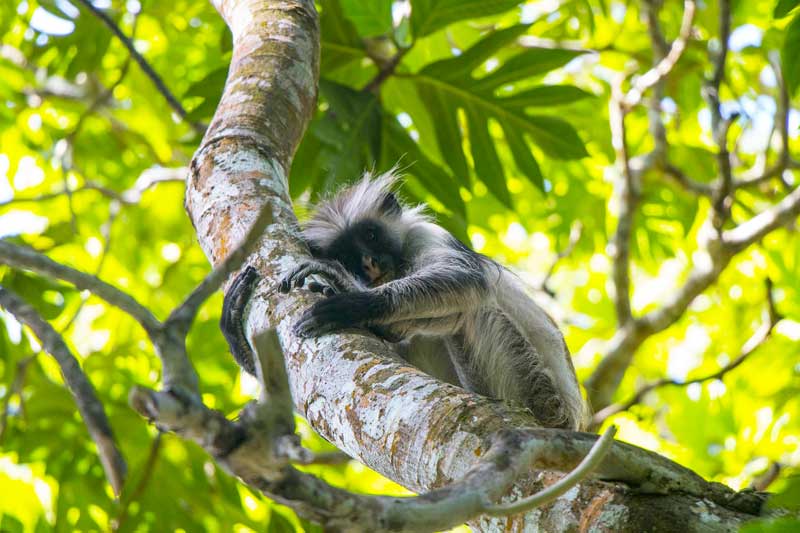
Those daring to dip beneath the surface and explore the underwater wonder world will have their pick of around 500 different fish species, turtles, octopuses, crabs and starfish to observe.
And then there are the marine mammal stars of course – humpback and sperm whales, bottlenose and spotted dolphins.
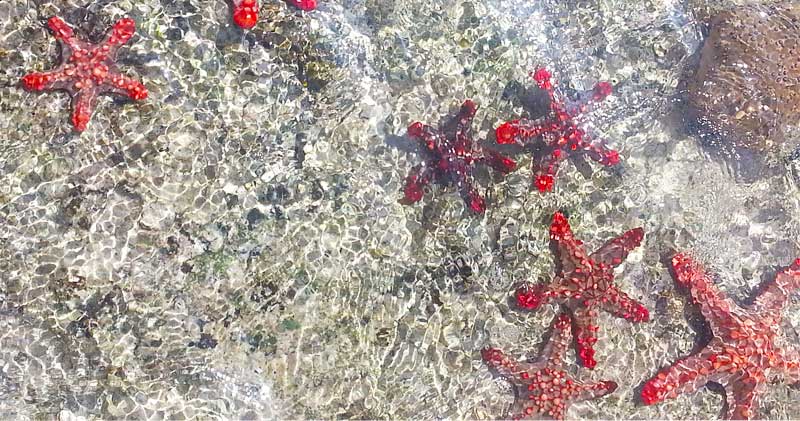
Red knob sea starfish
The Zanzibar red colobus monkey is endemic to the island and one of 54 terrestrial mammals occurring here. Other species include 23 different types of bats, small antelope like the suni antelope and the bush tailed mongoose.
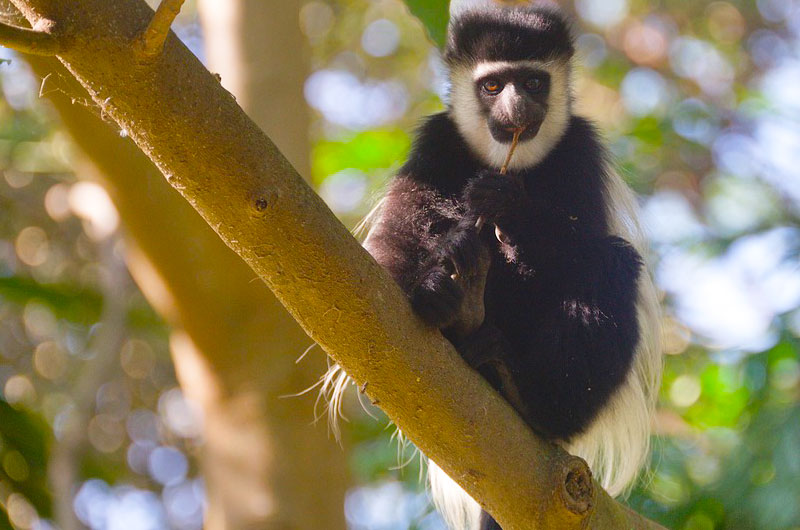
Colombus monkey
There are around 240 species of birds in Zanzibar, including the Pemba Sunbird, African fish eagle, Fischer’s turaco, Roseate tern and the Pemba scops owl.
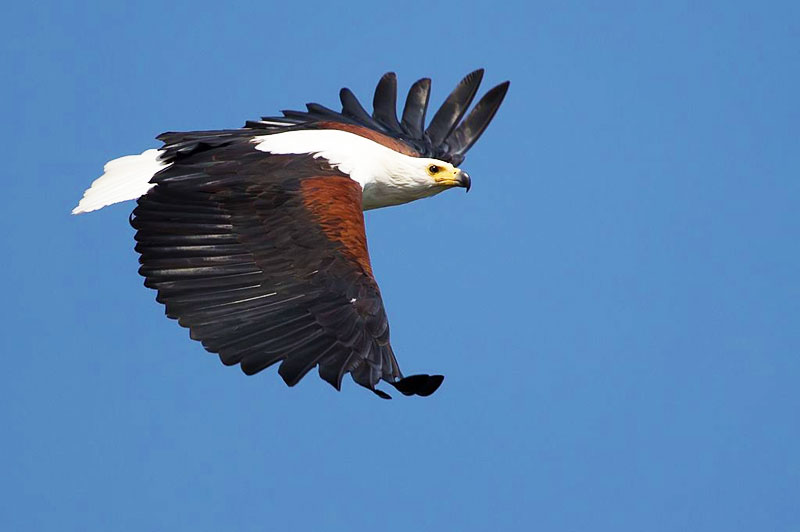
African fish eagle
Day tours in Zanzibar? Here are my top picks...
- Quad bike tour to a local village (4 hours)
- Stonetown food market and street food walking tour (3 hours)
- Zanzibar spice tour with traditional cooking lesson (3 hours)
- Rock restaurant and cave tour (6 hours)
- Private tour to Prison Island (3 hours)
My Final Thoughts
And that's a wrap on my Ultimate Zanzibar Guide! But don't just take my word for it - why not come and visit this gorgeous island in person? Share your adventure in the comments below and let's spread the love!

That sounds amazing thinking of going in November